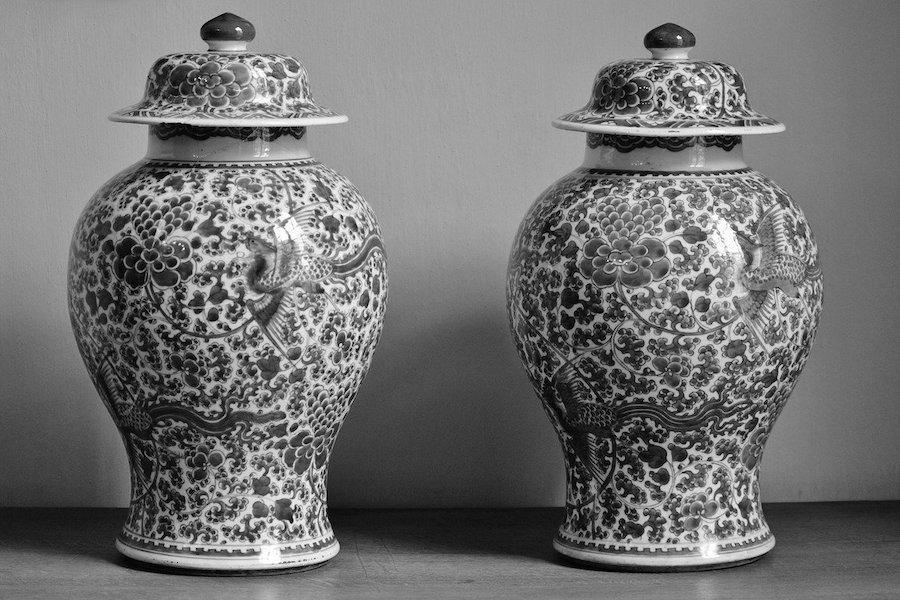When Marco Polo returned to Europe from his journey around Asia he brought back many things. One that attracted much attention at the time and went on to have a profound influence on European civilisation was an example of a kind of ceramic completely unknown to Europeans at the time. That was porcelain. He had no idea of how it was made and over the following centuries, as small amounts of this kind of ware made their way to Europe, all kinds of strange theories multiplied as to what porcelain consisted of and how it was made. It was one of the mysteries of the Orient for Europeans of the Middle Ages and later.
Porcelain is a distinctive kind of pottery. Made by combining kaolin clay with a type of stone (petunse), it has a unique set of qualities. It is pure white in colour and can be manipulated with far more facility than other mixes, to the point of being near translucent. Fired at a much higher heat than other ceramics, it is light yet very tough and resilient. If tapped it rings like a bell.
For centuries it has been prized and collected, often commanding a price that made it literally worth its weight in silver. It was one of the many things first invented in China. It first appears for certain under the Tang dynasty in the seventh century but was probably developed several centuries earlier, under the Han dynasty and then perfected during the Age of the Three Kingdoms that followed the collapse of the Han. During the Tang and Song eras, the art of making porcelain items and their decoration was refined to a supreme level.
Wealthy Europeans proved to have an insatiable appetite for fine porcelain and soon it became one of the major items that made voyages to the Far East highly profitable
The manufacture of porcelain also became one of China’s major industries, on a par with ironware, with massive factories around the empire, often owned and run by the imperial government. Much of their output was exported, to India, the Middle East and the Swahili coast, and this trade was highly lucrative for the Chinese – one result was that the way to make porcelain was kept a close secret.
Europeans were fascinated and captivated by porcelain from the time Polo brought it back, but they had to content themselves with the scraps and leavings they could get from the Middle East – until the later sixteenth century. At that point the Portuguese, Spanish and Dutch established long-distance maritime routes that connected Europe and East and South Asia. The result was a flow of Asian goods into Europe. Porcelain, along with spices, was one of the most valuable.
In fact, wealthy Europeans proved to have an insatiable appetite for fine porcelain and soon it became one of the major items that made voyages to the Far East highly profitable. Chinese producers for their part soon realised that they now had a new, massive market, and turned to producing specific lines designed to appeal to European buyers, with distinctive decorations and patterns. By the eighteenth century hundreds of shiploads of porcelain were going from China to Europe every year.
This trade had hugely important effects. In the first place it played an important part in driving the development of a truly global trading system (along with other key products like silver, sugar, furs and spices). Secondly, it had a major cultural impact upon Europe and led to the phenomenon of chinoiserie, the deliberate imitation of Chinese motifs and designs. The designs found on plates and ceramic pieces were copied and applied to a whole range of decorative arts, including furniture and wallpaper. More significantly, porcelain became associated with ideas that also came from China, to do with the way to live and the nature of the superior person. Porcelain products were associated with delicacy, refinement and self-restraint and with an entire style of not just crockery but living.
This led to the first case of directed commercial research and development, as potters around Europe tried to reverse-engineer porcelain in a systematic way
Most importantly, the demand for porcelain and its high price (because of the long and dangerous voyage required to bring it to Europe and the Chinese monopoly of production) proved to be an acute spur to innovation. European collectors, such as King Augustus the Strong of Saxony, were looking for ways to reduce the cost of their collectors’ obsession. This led to the first case of directed commercial research and development, as potters around Europe tried to reverse-engineer porcelain in a systematic way. In Saxony the first successful reproduction of porcelain occurred in the early eighteenth century, but it was still not a perfect copy, and this spurred further investigation. This finally bore fruit and led to the appearance of famous organised ceramics firms such as Wedgwood which were among the firms that pioneered the organisational and technological techniques that led to industrialisation.
The porcelain pot brought back by Marco Polo led eventually to two of the foundational features of the modern world: the existence of a truly global trade system and the appearance of systematic applied research and innovation, which spread from porcelain to other areas. Both eventually transformed the world.







